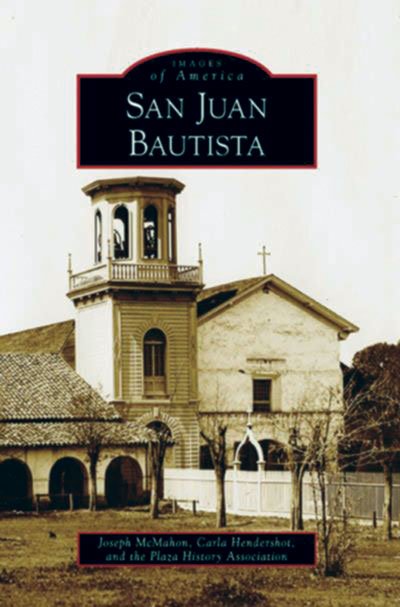I owe Joseph McMahon and Carla Hendershot an apology. I might
have accidentally caused the South Valley residents to write book
about San Juan Bautista’s history.
I owe Joseph McMahon and Carla Hendershot an apology. I might have accidentally caused the South Valley residents to write book about San Juan Bautista’s history.
It all started off innocently enough. A year or so ago, after perusing a copy of Arcadia Publishing’s “Images of America” book on Morgan Hill, I got the notion that the mission town of San Juan Bautista would make a wonderful subject for the local history series. I sent Arcadia a quick e-mail about my idea, and then forgot about my suggestion.
Recently, however, I found out that McMahon and Hendershot were busy putting together an “Images of America” book on, of all things, San Juan Bautista. Suddenly, I recalled the e-mail. I wondered if that correspondence to Arcadia had started the two historians down the road to their literary endeavor. As members of the town’s Plaza History Association, they were the right people to tackle the job.
If you’re a big fan of the mission village, you’ll have a ton of fun browsing through Arcadia’s San Juan Bautista volume. It’s a photographic time tour of the town, starting with the local Mutsun Indians and going up to the 1950s. The book’s photos of San Juan Bautista people are particularly moving. As you gaze at the long-gone faces, you start to see the humanity of the town’s men, women and children who lived lives so technologically different than ours. You’ll also sense that these people probably felt the same emotions and dealt with similar personal challenges that we do today.
The Spanish and Mexican settlement period is a fascinating part of the town’s history, and we’re treated in the book to several hand-drawn pictures of what the mission and its expansive plaza looked like as far back as 1847. Henry Miller, Gilroy’s wealthy cattle king, even sketched the mission in 1856, showing its adobe walls in a state of severe neglect.
It’s in the American period of San Juan Bautista’s history where photography really took hold in popularity, and so the book provides many stirring camera portraits of the people who lived in the San Juan area after California joined the Union in 1850. Among the many old-time pictures, the ones of the Breen family will catch your emotional interest the most. Before settling in San Juan Bautista, these Irish settlers had been trapped in the Sierras with the ill-fortuned Donner Party during the winter blizzard of 1846-1847. To see the somber faces of these men and women who experienced the Old West’s most dramatic survival story puts into perspective they were real human beings who suffered great personal trauma.
Browsing the book’s many exceptional turn-of-the-century photographs helped me better appreciate the evolution of the town. Several pictures show horse-drawn carriages and quaint Model T Fords of 100 years ago on streets where SUVs and Toyota Priuses now park. In a photograph taken around 1915, cowboys ride horseback alongside a old-fashioned car and demonstrates the important transition of transportation South Valley was experiencing during that era.
Henderson and McMahon got started on their book project last summer when Arcadia contacted the state historic park to inquire if someone with historical expertise would take on the task. The two spent many arduous hours combing through old photographs looking for the best images.
“Most of them came from the archives in the park,” McMahon said. “A lot of them came from the San Juan Bautista Historical Society. They were very generous in letting us use their pictures.”
Although the authors feel proud of their accomplishment, meeting their March deadline was often frustrating. “There was times when both Carla and I wanted to tear out our hair,” McMahon said with a chuckle. “But we like the book very much.”
During their labor of love, they worked closely with Arcadia’s Devon Weston. The junior publisher said the South Carolina.-based company seeks out local historians with an intense passion for preserving their community’s past. The books are thus always popular with local residents who want to see how life was like in their towns long ago.
“They’re extremely accessible to people,” Weston said. “They get people excited about history.”
Arcadia’s latest book providing a window to San Juan Bautista’s past should definitely get South Valley folks excited about their local history. It lets us discover the small town as it once was, and see that it really hasn’t changed all that much. Most of all, through its images of San Juan’s people of the past, the book lets us discover the town’s humanity.












